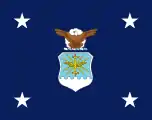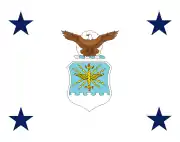Robert Seamans
Robert Channing Seamans Jr. (October 30, 1918 – June 28, 2008) was an MIT professor who served as NASA Deputy Administrator and 9th United States Secretary of the Air Force.
Robert Seamans | |
|---|---|
 | |
| United States Secretary of the Air Force | |
| In office February 15, 1969 – May 15, 1973 | |
| President | Richard Nixon |
| Preceded by | Harold Brown |
| Succeeded by | John L. McLucas |
| Personal details | |
| Born | Robert Channing Seamans Jr. October 30, 1918 Salem, Massachusetts, U.S. |
| Died | June 28, 2008 (aged 89) Beverly, Massachusetts, U.S. |
| Political party | Republican |
| Spouse(s) | Eugenia Merrill |
| Children | 5 |
| Education | Harvard University (B.S.) Massachusetts Institute of Technology (M.S., Sc.D.) |
Birth and education
He was born in Salem, Massachusetts, to Pauline and Robert Seamans. His great-great-grandfather was Otis Tufts.[1] Seamans attended Lenox School, in Lenox, Massachusetts; earned a Bachelor of Science degree in engineering from Harvard University in 1939 or 1940;[1] a Master of Science degree in aeronautics at the Massachusetts Institute of Technology (MIT) in 1942; and a Doctor of Science degree in instrumentation from MIT in 1951. Seamans also received the following honorary degrees: Doctor of Science from Rollins College (1962) and from New York University (1967); Doctor of Engineering from the Norwich Academy (1971), from the University of Notre Dame (1974), and from Rensselaer Polytechnic Institute (RPI) in 1974.
Early career

From 1941 to 1955 he held teaching and project positions at MIT during which time he worked on aeronautical problems, including instrumentation and control of airplanes and missiles. Positions that he held at MIT included: Instructor (1941–1945), Assistant Professor (1945–1950), and Associate Professor (1950–1955), Department of Aeronautical Engineering; Project Engineer, Instrumentation Laboratory; Chief Engineer, Project Meteor; and Director, Flight Control Laboratory.
Seamans joined the Radio Corporation of America (RCA) in 1955 as Manager of the Airborne Systems Laboratory and Chief Systems Engineer of the Airborne Systems Department. In 1958, he became Chief Engineer of the Missile Electronics and Controls Division at RCA in Burlington, Massachusetts.
NACA and NASA career

From 1948 to 1958, Seamans also served on technical committees of NASA's predecessor organization, the National Advisory Committee for Aeronautics. He served as a consultant to the Scientific Advisory Board of the United States Air Force from 1957 to 1959, as a Member of the Board from 1959 to 1962, and as an Associate Advisor from 1962 to 1967. He was a National Delegate, Advisory Group for Aerospace Research and Development (NATO) from 1966 to 1969.
In 1960, Seamans joined NASA as Associate Administrator. In 1965, he became Deputy Administrator, retaining many of the general management-type responsibilities of the Associate Administrator and also serving as Acting Administrator. During his years at NASA he worked closely with the Department of Defense in research and engineering programs and served as Co-chairman of the Astronautics Coordinating Board. Through these associations, NASA was kept aware of military developments and technical needs of the Department of Defense and Seamans was able to advise that agency of NASA activities which had application to national security.
Post-NASA career
In January 1968 he resigned from NASA to become a visiting professor at MIT and in July 1968 was appointed to the Jerome Clarke Hunsaker professorship, an MIT-endowed visiting professorship in the Department of Aeronautics and Astronautics, named in honor of the founder of the Aeronautical Engineering Department. During this period with MIT, he was also a consultant to the Administrator of NASA.
Seamans was also president of the National Academy of Engineering from May 1973 to December 1974, when he became the first administrator of the new Energy Research and Development Administration. He returned to MIT in 1977, becoming dean of its School of Engineering in 1978. In 1981 he was elected chair of the board of trustees of Aerospace Corp.
Secretary of the Air Force


In 1969 President Richard Nixon appointed Seamans to become Secretary of the United States Air Force, replacing Harold Brown. He assumed his duties as the 9th Secretary of the Air Force on February 15, 1969. During His tenure as Secretary of The Air Force, Seamans oversaw the Air Force transition turn control of the war against North Vietnam to the South Vietnamese government.[2] One of the transition process was the handover of several airbase which once served as United States Air Force Airbase to the South Vietnamese Air Force, such as Phan Rang Air Base.[3][2]
One of Seamans' achievements as Secretary of The Air Force was his pursuit of the modernization of several United States Air Force aircraft fleet.[3] Seamans try to replace the aging tactical fighter aircraft with a brand new advanced tactical fighter aircraft. As a result the project gave birth to a new modern advanced tactical fighter aircraft, the McDonnell Douglas F-15 Eagle which soon replaced the F-4 Phantom as the Air Force primary fighter aircraft.[3] Another new aircraft that the Air Force received during Seamans tenure as Secretary of the Air Force was the new Airborne Early Warning and Control (AWACS) Aircraft Boeing E-3 Sentry, which served as the Air Force primary airborne radar picket system aircraft in-order to detect aircraft, ships and vehicles at a long ranges.[3] The AWACS also capable to perform command and control of the battlespace during an air engagement by directing fighter and attack aircraft strikes.[3] Seamans also pursued the modernization of Strategic Bomber Aircraft, which resulted the "B-1" program in order to strengthen the Air Force Strategic Bomber fleet as part of the Strategic Air Command nuclear-deterrence.[3] The program resulted a new Strategic Bomber Aircraft, the Rockwell B-1 Lancer.[3] The B-1 made its maiden flight on December 23, 1974, but it did not came into service within The United States Air Force until October 1, 1986.
For much of his achievement for bringing modernization to the United States Air Force, Robert C. Seamans was credited for moving the process of modernization forward in a time when budgets were tightening as result of the scaling back of United States involvement in Vietnam War.[2][3] Seamans retired from his duties as Secretary of the Air Force on May 15, 1973 and was replaced by John L. McLucas.[2]
Personal life
Seamans married Eugenia Merrill on June 13, 1942, in Beverly Farms, Massachusetts. He had three sons (Robert III, Joseph and Daniel) and two daughters (Katharine Padulo and May Baldwin). Seamans also had 11 grandchildren.[1]
He died on June 28, 2008, in Beverly, Massachusetts, at age 89.[1]
Legacy and honors
- In 2001, the Sea Education Association named their new sailing research ship SSV Robert C. Seamans, in honor of their former Chairman and Trustee.[4]
- In the 1998 HBO miniseries From the Earth to the Moon, Seamans was played by Dann Florek.
- His last TV interview is featured in the Discovery Science Channel Series Moon Machines episode on the Apollo guidance and navigation system, recorded in the autumn of 2007 and first broadcast shortly after his death in the summer of 2008.
References
- Hevesi, Dennis (July 3, 2008). "R. C. Seamans Jr., NASA Figure, Dies at 89". New York Times. Retrieved 2008-07-03.
Robert C. Seamans Jr., NASA’s nuts-and-bolts manager of the Apollo moon-landing program, who later served as secretary of the Air Force and then as the first administrator of the federal energy research agency, died Saturday at his home in Beverly Farms, Massachusetts. He was 89.
- "Former Secretary of the Air Force Seamans dies". www.af.mil. Retrieved June 27, 2020.
- Seamans, Robert C (April 30, 1996). Aiming at Targets: The Autobiography of Robert C. Seamans Jr. (The NASA history series). US National Aeronautics and Space Administration. ISBN 978-0160489075.
- "About SEA Ships". Sea Education Association. Retrieved 2015-07-31.
- R. C. Seamans Jr. Project Apollo: The Tough Decisions. Monographs in Aerospace History Number 37. NASA SP-2005-4537, Washington, D.C., 2005.
- R. C. Seamans, Aiming At Targets: The Autobiography Of Robert C. Seamans Jr., Memoirs Unlimited, c1994.
- Air Force History Page on Dr. Robert C. Seamans at Archive.today (archived 2012-12-12)
- Tom Mueller, Crisis of Conscience, pages 76 – 77.
External links
- Interview with Robert Seamans for NOVA series: To the Moon WGBH Educational Foundation, raw footage, 1998
| Military offices | ||
|---|---|---|
| Preceded by Harold Brown |
United States Secretary of the Air Force February 15, 1969 - May 15, 1973 |
Succeeded by John L. McLucas |

